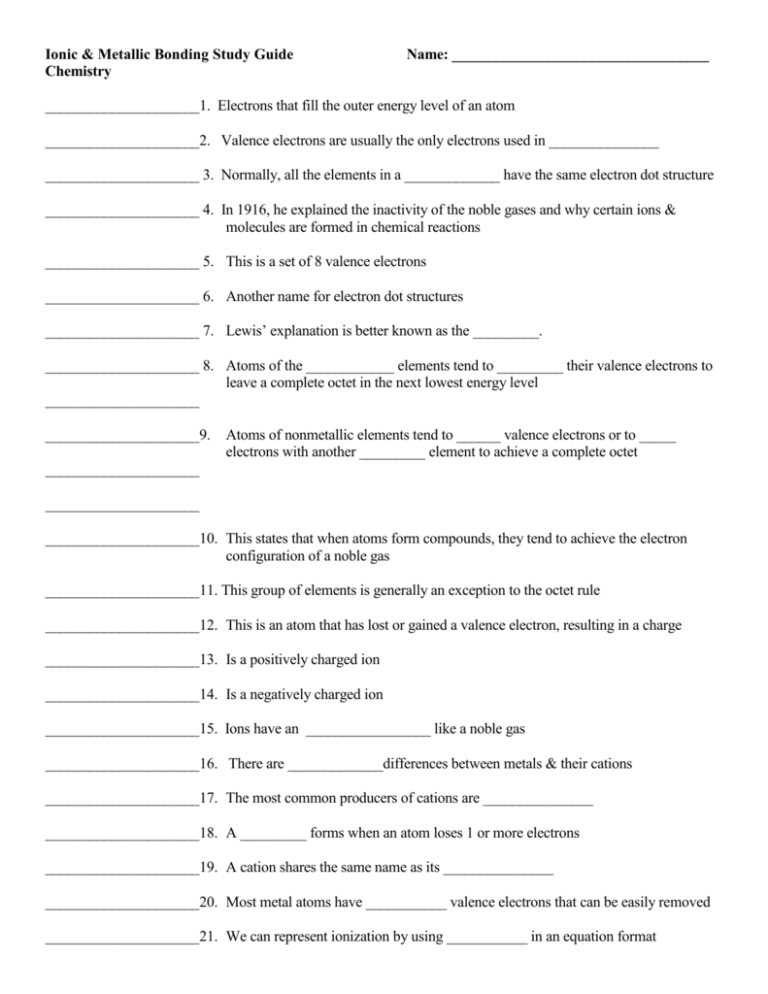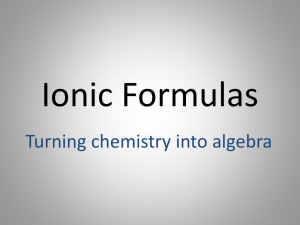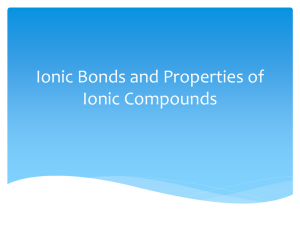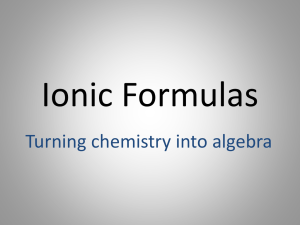Ionic and Metallic Bonding Study Guide
advertisement

Ionic & Metallic Bonding Study Guide Chemistry Name: ___________________________________ _____________________1. Electrons that fill the outer energy level of an atom _____________________2. Valence electrons are usually the only electrons used in _______________ _____________________ 3. Normally, all the elements in a _____________ have the same electron dot structure _____________________ 4. In 1916, he explained the inactivity of the noble gases and why certain ions & molecules are formed in chemical reactions _____________________ 5. This is a set of 8 valence electrons _____________________ 6. Another name for electron dot structures _____________________ 7. Lewis’ explanation is better known as the _________. _____________________ 8. Atoms of the ____________ elements tend to _________ their valence electrons to leave a complete octet in the next lowest energy level _____________________ _____________________9. Atoms of nonmetallic elements tend to ______ valence electrons or to _____ electrons with another _________ element to achieve a complete octet _____________________ _____________________ _____________________10. This states that when atoms form compounds, they tend to achieve the electron configuration of a noble gas _____________________11. This group of elements is generally an exception to the octet rule _____________________12. This is an atom that has lost or gained a valence electron, resulting in a charge _____________________13. Is a positively charged ion _____________________14. Is a negatively charged ion _____________________15. Ions have an _________________ like a noble gas _____________________16. There are _____________differences between metals & their cations _____________________17. The most common producers of cations are _______________ _____________________18. A _________ forms when an atom loses 1 or more electrons _____________________19. A cation shares the same name as its _______________ _____________________20. Most metal atoms have ___________ valence electrons that can be easily removed _____________________21. We can represent ionization by using ___________ in an equation format Ionic & Metallic Bonding Study Guide Chemistry Name: ___________________________________ _____________________22. Both the atom and its ion have the same number of _________ and __________. _____________________ _____________________23. Ions have an ______________, they form _____________, and conduct _________ when dissolved in water. _____________________ _____________________ _____________________24. Some elements form ________________ configurations when forming cations _____________________25. Name five elements that form pseudo noble-gas configurations _____________________ _____________________ _____________________ _____________________ _____________________26. An _________ is a negatively charge ion that is formed by the gaining of electrons _____________________27. The name of an anion typically ends in ________ _____________________28. Ions that are produced when atoms of halogens gain electrons are called _____ _____________________29. All halide ions have a charge of _______ _____________________30. Compounds composed of cations and anions are called ____________________ _____________________31. Ionic compounds are _____________ neutral _____________________32. An ionic compound is usually a combination of a _____ cation and a ______ anion _____________________ _____________________33. The total ______ charge of the cations must equal the total ____ charge of the anions in an ionic compound _____________________ _____________________34. Opposite _______ attract _____________________35. Is a chemical bond formed between two ions of opposite charges _____________________36. Chemists represent the composition of substances with _______________. _____________________37. This is the lowest whole-number ratio of ions in an ionic compound Ionic & Metallic Bonding Study Guide Chemistry Name: ___________________________________ _____________________38. Most ionic compounds are ______________ at room temperature _____________________39. The component ions within crystals have a repeating __________ pattern _____________________40. A chemical formula shows the ______ and __________ of atoms in the smallest representative unit of a substance _____________________ _____________________41. Ionic compounds tend to have high ________ and high ____________ _____________________ _____________________42. This is the number of ions of opposite charge that surround an ion in a crystal _____________________43. _________ and _________ ionic compounds in water can conduct electric current _____________________ _____________________44. Valence electrons of metal atoms can be modeled as a ____________________ _____________________45. Metals are made up of closely packed _______ _____________________46. These move freely between metal atoms _____________________47. This is the bond formed by the attraction between positively charged metal ions and the electrons around them _____________________48. This property of metals means that they are easily formed _____________________49. This property of metals means that they can be drawn into wires _____________________50. Metals have a __________________ structure _____________________51. The three main structural arrangements of metals _____________________ _____________________ _____________________62. An example of a metal with body-centered cubic structure _____________________63. An example of a metal with face-centered cubic structure _____________________64. An example of a metal with hexagonal close-packed structure _____________________65. Are mixtures composed of 2 or more elements, in which at least one is a metal Ionic & Metallic Bonding Study Guide Chemistry _____________________66. Name 3 alloys Name: ___________________________________ _____________________ _____________________ _____________________ 67. Steels are __________ alloys because the smaller atoms can fit into the spaces between the larger atoms _____________________68. Structure in which every atom, except those on the surface, have eight neighbors Short Answer 69. Explain why ionic compounds are able to conduct electric current when melted or dissolved in water. (2 points) 70. Why is it important that compounds have different properties than their individual atoms? Use an example to explain your answer. (2 points) Ionic & Metallic Bonding Study Guide Name: ___________________________________ Chemistry 71. Why is the whole number ratio 2:3 for aluminum oxide (Al2O3) rather than 1:1 like sodium chloride (NaCl)? (2 points) 72. How are the properties of metals explained by the sea-of-electrons model? (3 points) 73. Why are steels the most important alloys? (3 points) Ionic & Metallic Bonding Study Guide Chemistry 74. Name each cation or anion. (1 point each) Name: ___________________________________ a. K+ ______________________________________ b. O2- ______________________________________ c. Sr2+ ______________________________________ d. N3- ______________________________________ e. Cl- ______________________________________ 75. Write the ionization equations of the following cations & anions. (1 point each) a. Calcium ion b. Iodide ion c. Lithium ion d. Oxide ion e. Aluminum ion Ionic & Metallic Bonding Study Guide Name: ___________________________________ Chemistry 76. Draw the electron dot structures of the following elements. (1 points each) a. Lithium f. Krypton b. Fluorine g. Hydrogen c. Phosphorus h. Helium d. Aluminum i. Oxygen e. Germanium 77. Use electron dot structures to predict the formulas of the ionic compounds formed from the following elements. (1 point each) a. Potassium and oxygen b. Calcium and nitrogen c. Sodium and chlorine d. Aluminum and oxygen e. Lithium and phosphorus







